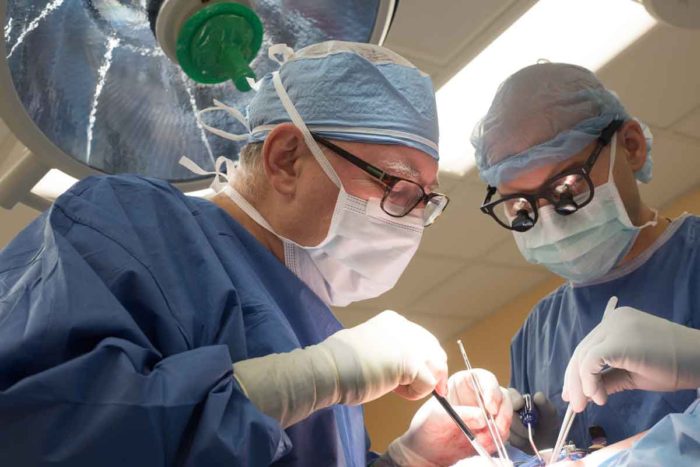Surgery helps MLB pitchers overcome nerve-compression injuries
Following procedures, most pitchers perform at, or better than, pre-injury play
 Robert Boston
Robert BostonRobert W. Thompson, MD, (left) professor of surgery at Washington University School of Medicine in St. Louis, operates on a patient suffering from thoracic outlet syndrome, a nerve-compression injury. He is assisted by William Chapman Jr., MD, a surgical resident.
For Major League Baseball (MLB) pitchers, a nerve-compression injury in the shoulder can signal a career’s end. However, new research shows that surgery to correct the injury can help MLB pitchers return to the game and perform at, or better than, pre-injury play, according to a study at Washington University School of Medicine in St. Louis.
The research, published online in the Annals of Vascular Surgery, is the first to examine surgical outcomes in MLB pitchers treated for what’s known as neurogenic thoracic outlet syndrome (TOS), said Robert W. Thompson, MD, a professor of surgery at the School of Medicine and the study’s first author.
Thompson has performed the surgery on dozens of elite athletes, including MLB pitchers. “It is good news for players with neurogenic TOS who have traditionally faced bleak career prospects after being placed on the disabled list,” said Thompson, director of the university’s Center for Thoracic Outlet Syndrome.
Repetitive overhand movement makes MLB pitchers susceptible to the injury, a rare and disabling condition caused by compression of a nerve bundle that controls muscles and sensation in the shoulder, elbow, wrist and hands. Symptoms include pain, numbness and tingling.
The injury can be difficult to diagnose, and some players face considerable disability before the surgery, which involves removing the first rib and two small scalene muscles, as well as scar tissue from around the nerves. Surgeons access the problem areas via an incision in the neck just above the collarbone.
For the study, researchers used traditional and advanced pitching-performance metrics to examine 13 MLB pitchers who underwent surgery for neurogenic TOS from July 2001 through July 2014.
Of those, 10 pitchers returned to professional baseball and sustained play at or above pre-injury levels.
Six of the 10 pitchers remained active in the MLB when the study ended. The other four retired due to factors unrelated to their nerve-compression injuries.
“The study provides the first strong evidence that thoracic outlet decompression, coupled with an ample period of postoperative rehabilitation, may offer effective treatment for professional baseball pitchers with neurogenic thoracic outlet syndrome,” Thompson said.
Researchers were limited by the small number of pitchers available for analysis, Thompson said. “It undoubtedly reflects the relatively rare occurrence of neurogenic TOS compared with other conditions that more frequently affect MLB pitchers,” he said. “Because it is not as well-known, there is a difficulty in diagnosing the condition and a possible reluctance among elite athletes to consider surgical treatment.”
However, the procedure seems to be gaining recognition, Thompson said, since most of the pitchers studied were operated on after 2010, and relatively few pitchers underwent the procedure before then. “It is still unclear whether this reflects an increase of elite athletes with neurogenic TOS,” he said. “But it’s possible given the rigor of contemporary sports training, high performance expectations and the frequency of upper-extremity injury.”
Another factor to consider is that the athletes studied underwent surgery for neurogenic TOS after a period of declining performance and a prolonged search for a diagnosis, Thompson said. “It is possible that with earlier diagnosis and prompt surgical treatment, athletes would experience a more rapid recovery and rehabilitation,” he said.
Other researchers who participated in the study include senior author Gregory J. Pearl, MD, a vascular surgeon at Baylor University Medical Center and Texas A&M Health Sciences Center; and Tyler Hadzinsky, baseball operations analyst for the St. Louis Cardinals Baseball Club.






